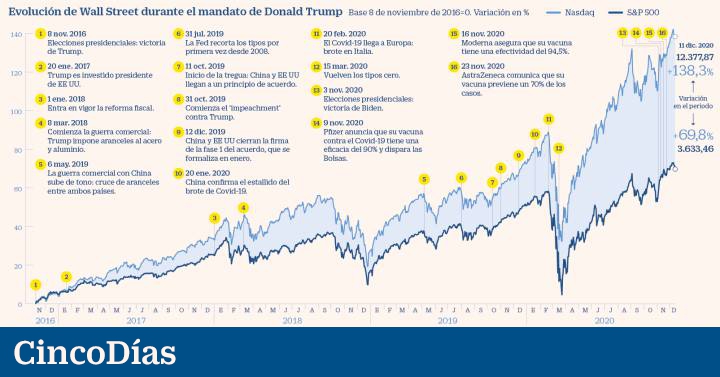Joe Biden will be, very predictably, declared the winner of the US presidential elections today after the meeting of the members of the Electoral College. The democrat will not be inaugurated until January but with this step the fight started by the current president, Donald Trump, since the results of the November 3 elections were known. The republican considers that there was a “massive fraud” and has requested the action of the courts, but his efforts have been in vain.
Thus, Trump’s term will end as it began, surrounded by conflicts and uncertainty and with a greater power of Twitter messages over official communications. However, Wall Street has reacted well to this impulsive policy, surpassing maximum after maximum since the November 2016 elections and improving the result obtained in the previous four years, during the second term of Barack Obama.
Since its victory was known in 2016, the S&P 500 has added 70%, while the Nasdaq, which has benefited from the momentum of technology, has appreciated more than 120%. However, between Obama’s reelection in 2012 and the presidential elections in 2016, they rose 50% and 72% respectively.
The change of political sign in the Oval Office has not altered the mood of investors who, more concerned about the pandemic, have added new records when it became known that vaccines against Covid-19, with a high level of effectiveness, could begin to be inoculated in early 2021.
And it is that the coronavirus has not been able to with the strength of Trump. At the beginning of its spread, Wall Street suffered sharp falls, like the rest of the international stock exchanges, with falls of around 30% between February and March, when the virus reached the West. Despite everything, so far this year its indices are among the few that have risen: the S&P 500 is 13% and the Nasdaq, 37%. This means that if the virus had not spread across the planet, surely the stock market result of the Republican mandate would have been even higher.
After this behavior, which if compared to Europe is even more remarkable, since the Eurostoxx50 has reached 15% since 2016, there are a series of policies in favor of the country’s large companies and protectionist decisions that have led Wall Street to collapse in a day and rebound with just a tweet in which the leader reinforced the suitability of his strategy.
His first year in office ended with a rise of 19% for the S&P and 28% for the Nasdaq after shaping the tax reform, approved in January 2018, which lowered taxes on families and companies. This news was not clouded by a summer of tension in the face of a possible nuclear war due to the confrontation with North Korea during which Trump threatened “a fire and a fury never seen before.”
The trade war with China and the steel and aluminum tariffs also imposed in Europe did weigh on the US market in 2018, which closed with a fall of between 4% and 6%, also affected by the fear of an economic crisis . It was not until the summer of 2019 when both countries approached positions and closed the first phase of the agreement. The conflict, which is not over yet and with which Biden will have to deal, has strengthened American companies, despite their dependence on abroad. Apple, for example, with suppliers in the Asian country, has become the first American company to reach a billion dollars of capitalization.
Covid-19 was able to disrupt the evolution of Wall Street in previous years, but the fall did not last long and since the end of March, despite the confinements – less harsh than in Europe – and the resulting economic crisis, it began to recover. The US is the country that has registered the most deaths so far from the virus and while the Old Continent is now recovering from the second wave, on the other side of the Atlantic the third wave would have already ended. Trump has denied the existence or lethality of the virus from the beginning and even after falling ill shortly before the election. Biden will take a turn in this direction but will arrive at the White House when the vaccines have already begun (the US will begin to inoculate Pfizer’s today). Wall Street has already celebrated this apparent victory against the virus with a rise of 4% since the pharmaceutical companies published the good results of their final tests.
Help from the Federal Reserve
- Trump criticism. The Federal Reserve has also been a target of Trump, who repeatedly called for lowering rates. Its president, Jerome Powell, remained unmoved and raised the price of money four times in 2018.
- Back to zero rates. With the new year, Powell paid attention to the weak macroeconomic data and changed his strategy, lowering rates in July 2019 for the first time since 2008. The situation has no longer been able to be reversed. The pandemic and fear of the effects on the economy led the Fed to cut rates twice in two weeks until they were at 0%, a level at which the agency says they will be for the next three years.
–
–
– .


